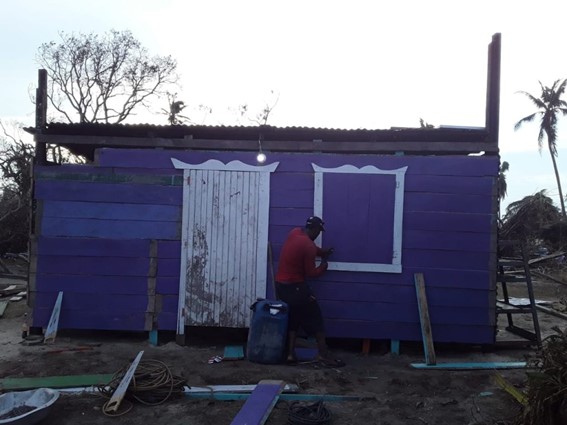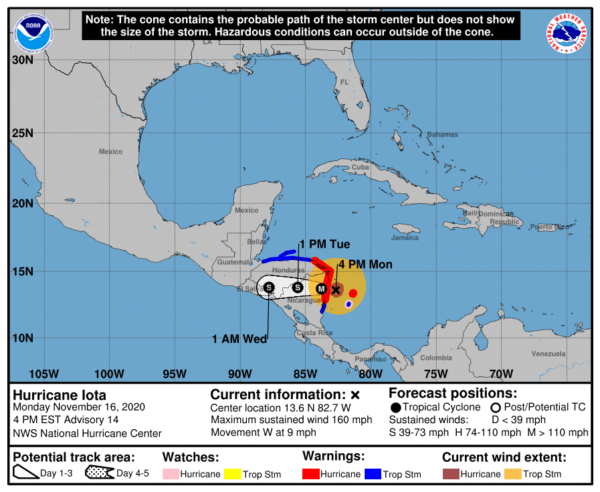Iota Advances Dangerously, More Force than Eta

Hurricane Iota will hit the North Caribbean of Nicaragua Monday afternoon, less than two weeks from when Eta hit in the same area. Inhabitants return to shelters
By Cynthia Torrez (Confidencial)
HAVANA TIMES – Nicaragua’s North Caribbean is on alert for Hurricane Iota, the second to reach the area in just thirteen days. The phenomenon is projected to be more catastrophic than Hurricane Eta. Not only because the eye of the hurricane is better organized, but because everything indicates that its dissipation will be slower than that of the first cyclone.
Flooding is also a big cause for concern. Agustin Moreira, an agricultural meteorologist from the Humboldt Center spoke on the Esta Semana program on Sunday night. He explained that accumulated rainfall could reach 20 to 30 inches in already saturated soils.
In contrast to the powerful Eta, Iota has an even larger diameter, which means it will have a hurricane force of 35 kilometers out from the center of the cyclone and tropical storm force winds of 205 kilometers outward, the specialist said.
“We can expect potentially catastrophic winds, a life-threatening storm surge and rain impact in Central America,” warns the National Hurricane Center (NHC). For this reason, Moreira recommended that the population stay at least three kilometers from the coast, because the waves could reach up to 4 meters high.
The Pacific will also be affected
Northeast Nicaragua and Honduras will be the most exposed to Iota’s fury. The phenomenon would begin to be felt on Sunday night and Monday morning in the areas of Bilwi and the communities of Wawa Bar and Haulover, Moreira said.
However, that does not mean that the Pacific will not feel the force of the cyclone. In the southern area, 5 to 10 inches of rain could accumulate. From Monday through Wednesday will be the most intense period of the Iota impact, and the situation is expected to improve on Thursday.
Moreira noted that a hurricane is made of three phases. He said the most destructive is the one that which occurs when it seems that everything has passed.
By Monday at 4:00 p.m. (ET) the center of Iota is moving west at a speed of 9 mph, with winds of 160 mph (260 kph). Moreira stressed that “this hurricane is stronger than Eta. The difference is that Iota is bigger and with concentration bands which are more defined. Likewise, it has very compact walls,” which generates more rain and wind gusts.
Villagers from the North Caribbean area and Juana Bilbano, director of the Center for Justice and Human Rights of the Atlantic Coast of Nicaragua (CEJUDHCAN), told Confidencial that they were worried because Eta’s wound is still very fresh. The first hurricane threw roofs, rustic wooden houses and trees on the ground and left wells contaminated. Many people from Wawa Bar and Bilwi only have what they took to the shelters. When they returned after Eta, the sea had swallowed almost everything.
Evacuations and shelters
The National System for the Prevention, Mitigation and Attention to Disasters (SINAPRED) carried out evacuations in communities at high risk from the hurricane. As of Monday morning the authorities had not provided an estimate of the total number of displaced. The Nicaraguan Army indicated on Saturday they evacuated 1,217 persons to shelters in Waspam, North Caribbean, by river and land. These included 682 minors from the communities of Bihmona and Cabo Viejo. They also transferred 49 tons of humanitarian aid from Puerto Cabezas to that area.
Evacuations continued Sunday, and just over 200 people were taken from Karata to shelters in Bilwi. SINAPRED also confirmed that the population of Cayos Miskitos was already in a safe place and that boat departures are suspended.
In Waspam, the Miskito priest Rodolfo French, in charge of the San Rafael parish, said that the city is full of the population that the municipal authorities have evacuated from other places. He estimates that there are about four thousand people in the various shelters. These include several educational facilities. He learned that the population in the shelters has eaten and that the people in the city are looking for safe places to take shelter. In the streets of that municipality military and police presence is observed.
The projections of the Humboldt Center, based on NHC data, is that Iota will enter between Cabo Gracias a Dios and Bilwi, passing through the municipalities of Waspam, the Mining Triangle, and its exit possibly will affect Wiwili and San Jose de Bocay, “leaving strong winds with a large accumulation of rains that could cause major flooding of rivers that could endanger life.”

One disaster after another
A man patches the little purple wooden house with nails. Around him everything is a mess: pieces of wood here and there, zinc sheets, fallen trees and bent palm trees. The footprint left by hurricane Eta remains visible to anyone who comes to Wawa Bar, one of the most affected communities in the North Caribbean.
Nature has had no mercy on these communities, also hit by poverty for years. Candida Tebas, a Wawa Bar community member, explains that before they found out about Iota, her cousins rented a chainsaw to cut trees and start cleaning. Families gathered wood hoping to improvise a house and bring back their relatives who were still in shelters.
From the Government aid, they brought them three pounds of rice and some oil, also mats and water, and that’s it. They were told that zinc sheets would reach the area, but they ignore how distribution will be. Until Saturday, no authority had come forward to inform them.
In addition to the lack of a roof, water is another of the most urgent needs of the population of Wawa Bar. The wells remain contaminated and they have not been able to clean them. People had to travel by sea to Puerto Cabezas to get water. The last time the community received three barrels and some water cans. They settle with “a little bucket,” [per family] some of Tebas’ cousins said.
“No authority comes to explain to us, to tell us what is happening, how and when they will help us. Nothing, none of that. No one has come to say: ‘look, you have to wait, zinc sheets will come, or we are going to build your houses or we are going to give you something, nothing,’” Tebas told Confidencial.
Now, with the arrival of Iota the population had to leave again and their questions remain unanswered. Wawa Bar once again remained deserted by another hurricane.

More than ten days in shelters
Bilbano, the director of CEJUDHCAN, was concerned about the situation of the 14 communities of the Whanky Maya territory. They have been sheltering in Koom and Wasla, in Waspam, for more than ten days. “Yes, conditions are very bad because in a church there are more than a thousand people. They cannot even lie down on the floor because there are too many people,” explained the human rights defender.
The women were given a hammock or a sheet, but they need nets for mosquitos, because there are too many. They do not have kitchen utensils, such as plates and glasses; nor flip flops. They said they do eat, but little, because each woman must share with her children, who average four or five. What would have been a few days while the water that entered the houses lowered, has become an uncertain period of return due to the impact of Iota, said Bilbano.
The human rights defender explained that the aid the government sent is not enough. Her group argued with those in charge of the place. They even wanted to rip up the aid control documents that they presented them. Due to this behavior, other civic organizations are afraid to bring aid, she pointed out. Priest French brought them 600 aid packages this weekend, mainly for feeding the children.






